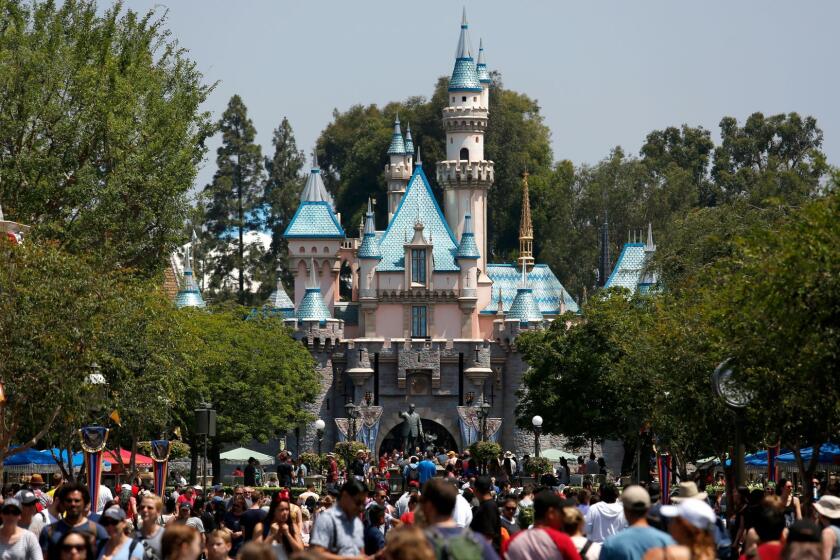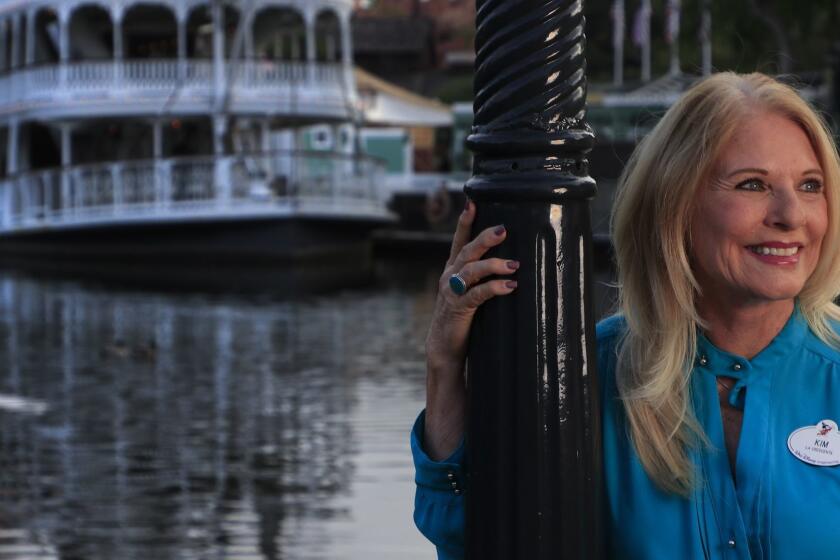Commentary: What works, what’s missing and what needs fixing at Disney’s Galaxy’s Edge
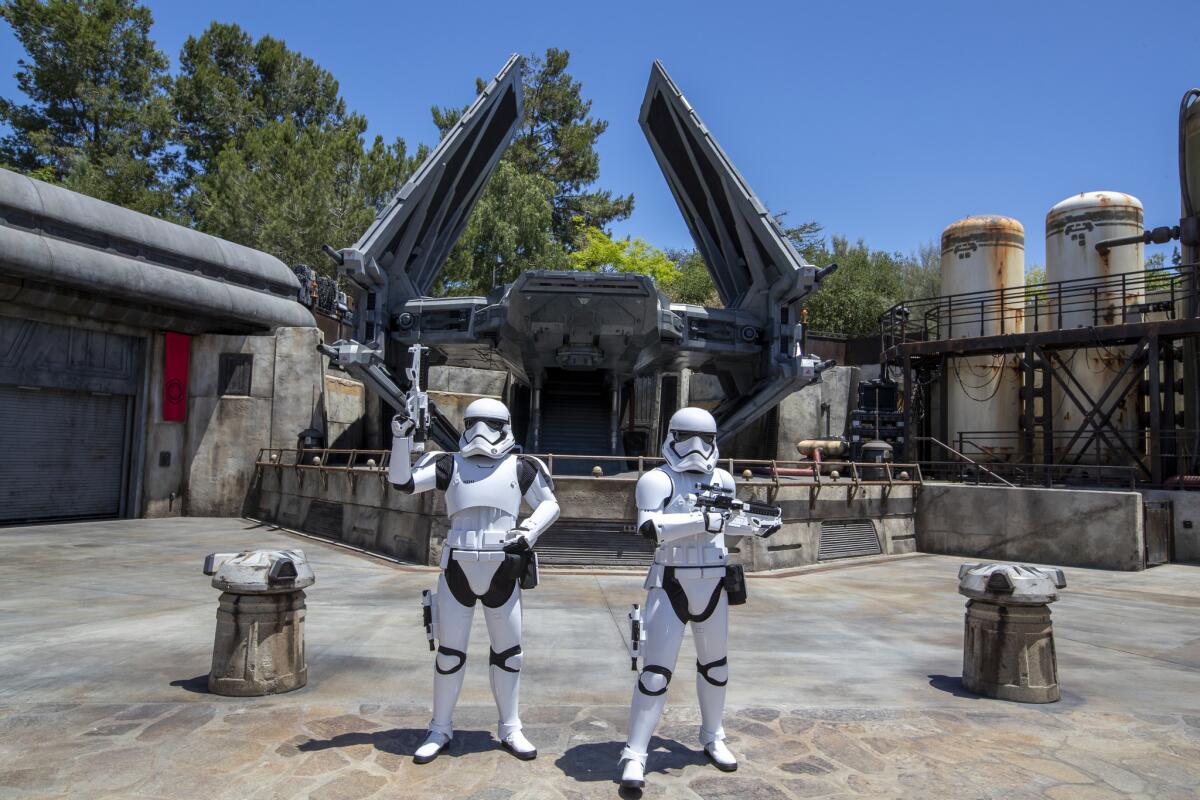
- Share via
In late May, about 10 days before Disneyland opened Star Wars: Galaxy’s Edge, I booked a weekend near the resort believing I’d outsmart everyone and find a near-empty park before the wave of visitors expected to check out the new 14-acre land.
Instead, I found claustrophobia-inducing crowds flooding the paths of Disneyland and Disney California Adventure, and waits for people-eating attractions such as Pirates of the Caribbean topping 60 minutes.
In hindsight, I should have waited until Disney opened Galaxy’s Edge for the crowds to evaporate. Little did I know that soon after its May 31 opening, the parks would be a dead zone, with every attraction a walk-on and blissfully bare sidewalks.
Images of an empty Disneyland inundated social media, shaping public perception over the summer. Headlines about the sparse crowds appeared, some even using the word “flop” to describe the largest single land expansion in the storied theme park’s history — also its most technologically advanced and story-driven. Then came the executive shuffling within Disney’s parks and resorts department, with speculation that people were losing their jobs over the performance of Galaxy’s Edge. Disney leaders immediately pushed back on such a story line and called Galaxy’s Edge “successful.”
But the perception that there’s a problem — or, rather, lower-than-expected demand for Galaxy’s Edge — has been fueled by Disney CEO Bob Iger himself as much as it has been by any media account. Disney in August reported a 3% dip in attendance for its domestic theme parks, despite the opening of its most buzzed-about resort addition since the launch of Cars Land in 2012.
Among the reasons cited by Iger were fears of overcrowding and a price increase at Disneyland’s parks and surrounding hotels.
“All of those factors contributed to attendance that was below what we would have hoped it would be,” Iger said.
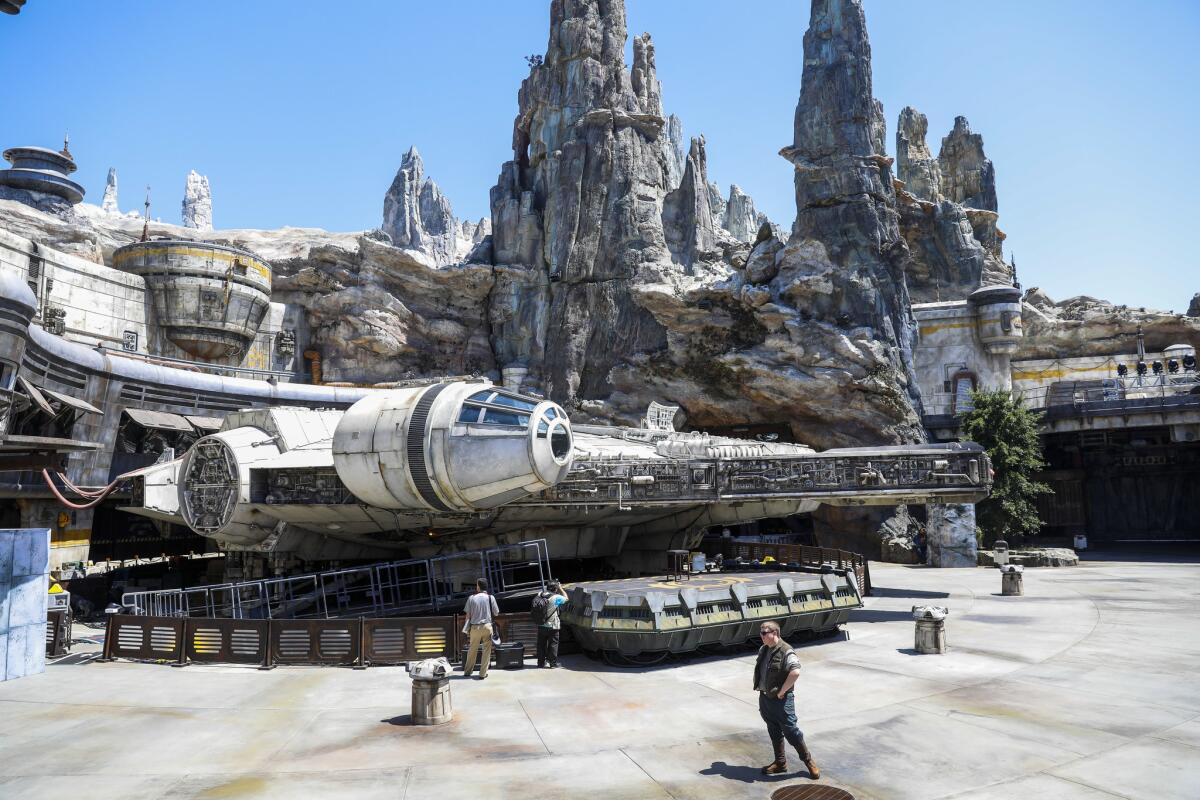
Evolutionary design
Theme parks, of course, are a living, breathing art form, one that evolves daily, weekly and monthly and is subject to constant tweaks, additions or subtractions based on guest behaviors. The Disney California Adventure of today is a completely different park than the Disney California Adventure that opened in 2001. And so four months into arguably the most ambitious addition to Disneyland, a park that remains not just a sculptor but a cornerstone of American pop art, it’s safe to ask what’s working, what’s missing and what was over-promised when it comes to Galaxy’s Edge.
First, let’s get it out of the way: Galaxy’s Edge isn’t finished.
A recent two-hour special on Freeform dedicated much of its airtime to the in-development ride Rise of the Resistance, and early indications are that the trackless attraction, opening in Florida on Dec. 5 and the next month in Anaheim, should be the showstopping crowd-pleaser the land needs — a thrilling, 15-minute-plus escape from a gargantuan spaceship. Of course, it’s fair to ask whether Disney should have waited until Rise of the Resistance was completed before opening the land to begin with. (To avoid an uncomfortable public relations narrative, the answer, in hindsight, is yes.)
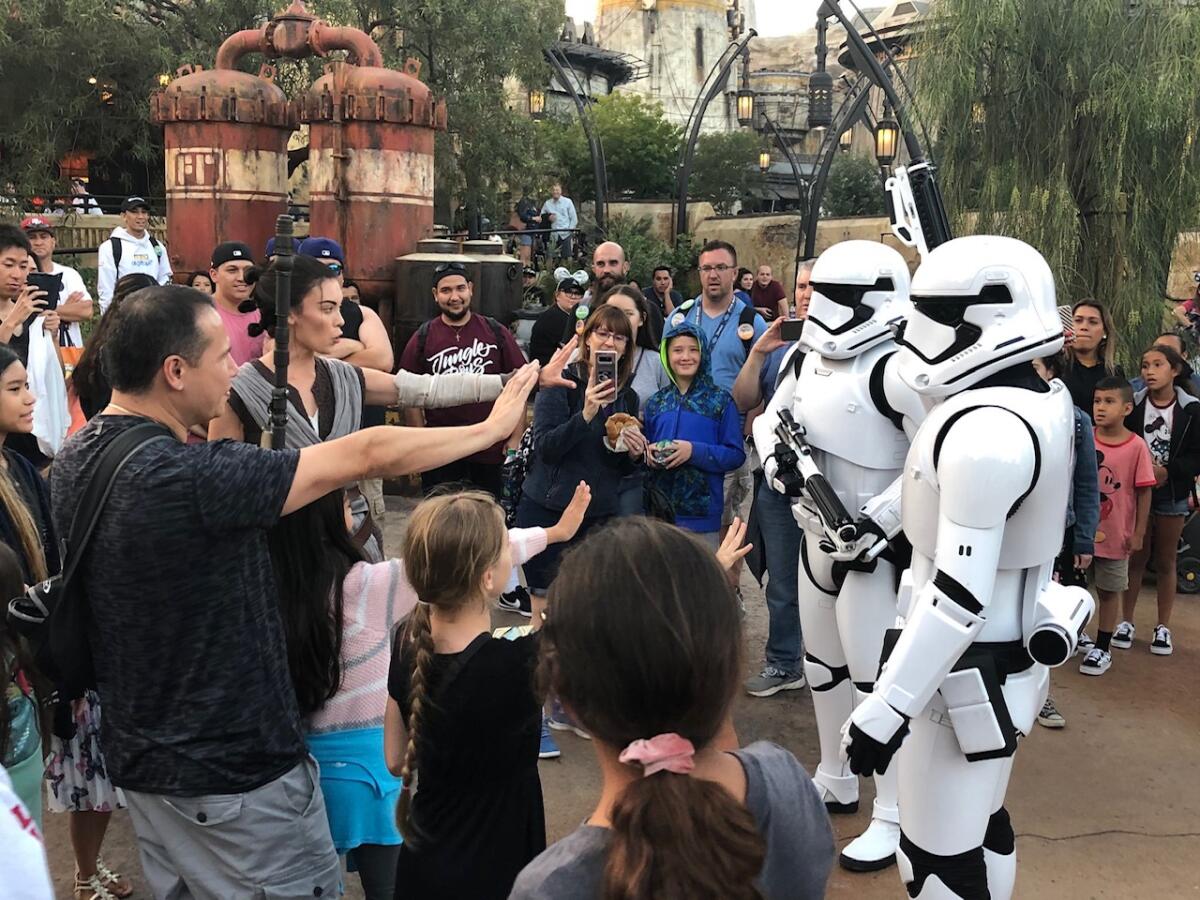
Disney also took design risks with Galaxy’s Edge, a land that pivots away from passive theme park entertainment and aims to put visitors inside an evolving narrative. When the land opened, I wrote that the crowning achievement of Galaxy’s Edge is that it feels like a real place. That holds true. I’ve spent up to eight hours solely in Galaxy’s Edge and like the feeling of being a tourist exploring the marketplace and stalls of the land, where a gift shop is cleverly disguised as a bustling thoroughfare.
But design choices that place Galaxy’s Edge specifically between 2017’s “The Last Jedi” and this year’s “The Rise of Skywalker” also hamper it. The land’s sole open ride, Millennium Falcon: Smugglers Run, is a technical marvel that gives players control of the ship made famous by Harrison Ford’s Han Solo and inherited by Daisy Ridley’s Rey, only they’re not involved. Once we get past the thrill of controlling the vessel, we realize the elaborate story of the ride is essentially an errand, one ultimately overshadowed by the ride’s elaborate queue.
Smugglers Run at the moment feels less like a Disney attraction and more like a piece of infrastructure constructed primarily to fit into a broader Lucasfilm-directed narrative. It’s an engineering rather than an emotional feat.
If Galaxy’s Edge truly wants guests to “lean in” and take an active role, as Walt Disney Imagineering keeps telling us today’s theme park attendees are wont to do, some things will likely have to change sooner rather than later.
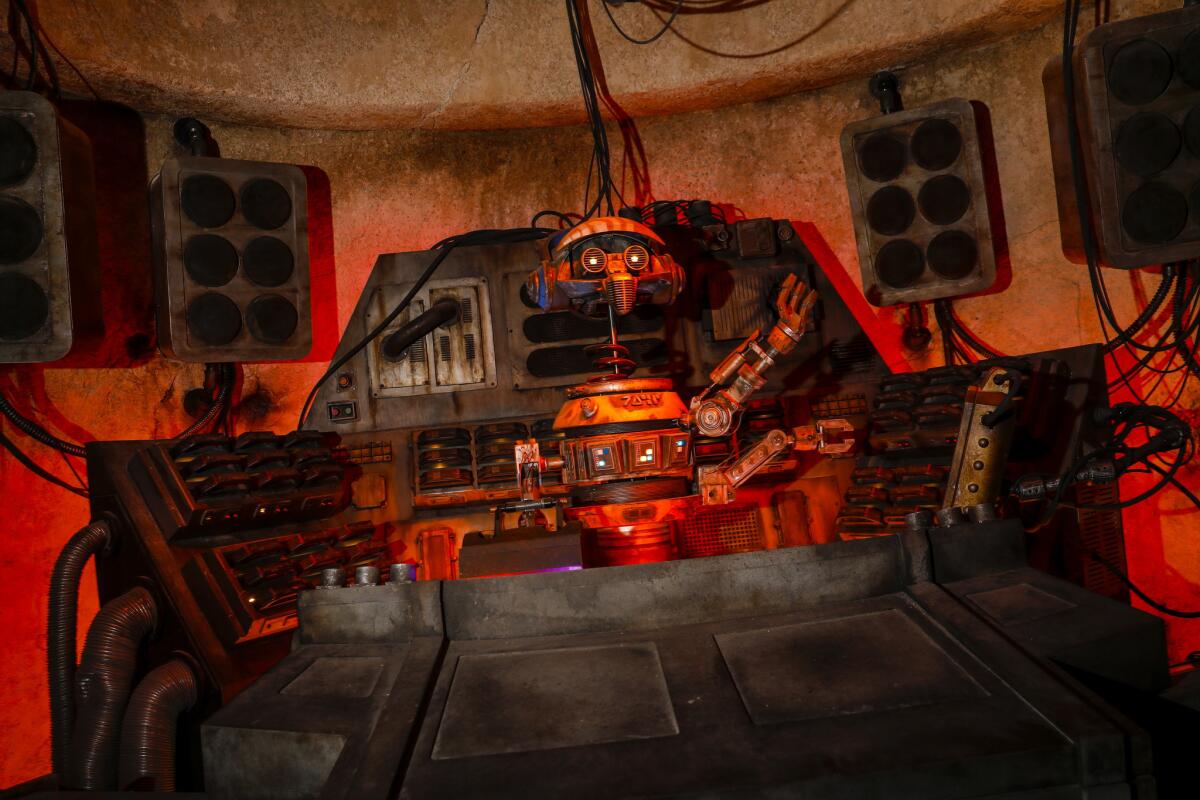
Character flaw
For starters, Disney will need to admit failure on the current incarnation of one of the land’s core concepts — the idea that each staffer, or cast member, in park parlance, is capable of being an actor who can improvise and sell guests on the idea that the fictional planet of Batuu is a real place.
“I like to say that we have more characters in this land than any land we’ve ever done because each one of our cast members has a backstory,” parks head Bob Chapek said in a recent interview.
But I’ve made it a point to ask the cast for their backstory on each of my two-dozen-plus visits to Galaxy’s Edge, and too often the response I get is a look of dread. I’m now suddenly the guest wanting to talk “Star Wars” lore in a crowded marketplace of people wanting to buy plushies.

What few interactions I’ve seen with proper actors in Galaxy’s Edge have been, to employ an overused Disney word, magical. I was brought to tears on a Saturday evening when I saw a stellar Rey lead a pack of guests on a mission to rid Black Spire Outpost, the city at the heart of Batuu, of Stormtroopers. She stealthily crouched and hid behind barriers as her ever-growing team of Force-sensitive recruits, all strangers just seconds earlier, were ready to repel evil. Watching a dozen people quote Rey in unison, and then witnessing the Stormtroopers turn around and leave the area, was the kind of play that can only happen on a grand set such as Disneyland. I loved it, I want more of it and I’ve never seen it happen again.
Disney must know that these are moments that create theme park fans for life. It reminded me of my visits as a child to the late great Adventurer’s Club in Florida, the former bar in the nightclub area of Walt Disney World that was filled with actors and puppeteers and stoked my interest not just in the imagination of the arts but also the excitement of world travel. Nineteen million people or so are estimated to go to Disneyland each year, and I bet the reason most keep coming back is a personal connection that happened during one of their visits. Rebellious scenes with Rey should be near-regular occurrences, not rarities.
Admittedly, these are elements that cannot easily be fixed without hiring pricey actors. At the opening night press event, the land felt activated in a way it hasn’t on subsequent visits; it even boasted an impressive special effects show that had rebel spy Vi Moradi and fan favorite Chewbacca fending off First Order troops. With gymnastics-worthy choreography, unexpected blaster fire and light pyrotechnics, this show was not only ready for prime time but also did a better job of selling the land as a place of conflict between the good Resistance and evil First Order than anything that currently exists in Galaxy’s Edge.
This is your brain on Disneyland: A Disney addict’s quest to discover why he loves the parks so much
My name is Todd and I am addicted to Disney theme parks.
Having had the privilege of glimpsing it, I can report the land feels empty without it, especially as Imagineering execs were so keen to point out the numerous not-so-hidden stages that dot Galaxy’s Edge and largely sit bare, save for an occasional Stormtrooper patrol. Instead, the land feels like an elaborate game board that is missing key pieces.
I can’t help but think that one reason those who visited Galaxy’s Edge during its first month — when the park utilized a fully booked reservation system to keep crowds manageable —aren’t rushing back is the gap between what was sold to guests and what actually is.
There is, for instance, no sit-down restaurant. It’s easy to judge the omission without having access to Disney’s budgets and financials. But the fact that a cantina remains Galaxy’s Edge most in-demand attraction shows that axing the promised “dinner club” was a grave oversight.
It makes sense that the cantina is so popular. The neighborhood bar is filled with otherworldly wonders that anyone who saw the 1977 film “A New Hope” wants to visit — a mostly safe haven for weirdos and outcasts.
But even the cantina, as lively as it is, hasn’t fully lived up to its billing. Disney was keen before Galaxy’s Edge opening to talk up the land’s interactive elements — to note that the cast would be able to access how well someone did or didn’t pilot the Millennium Falcon on the land’s simulator ride. Crash it, and a bounty hunter might tap you on the shoulder and even scold you while you’re in the cantina, Disney said more than once. Only there are no bounty hunters populating Black Spire Outpost, and succeeding or failing on the ride Millennium Falcon: Smugglers Run has no real consequences other than depositing some imaginary credits in the Play Disney Parks mobile app — credits that currently have no value in the land.
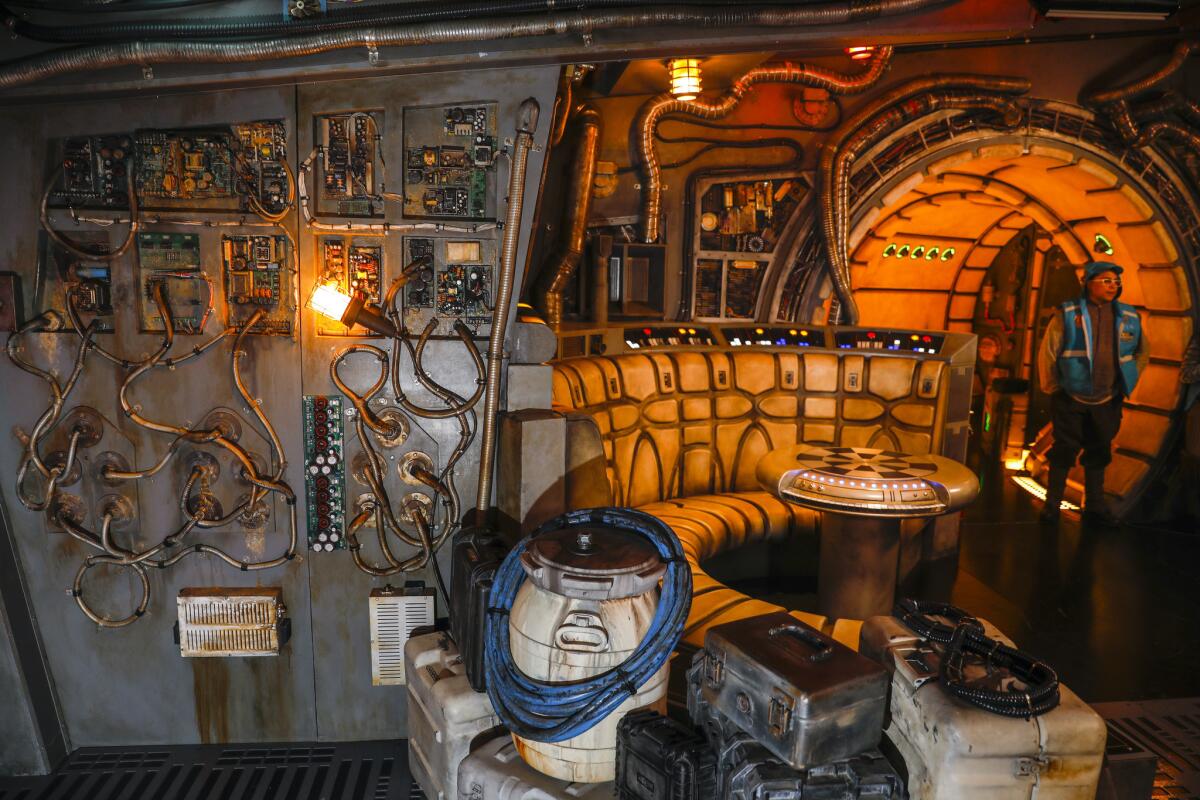
One can say these are nitpicks and I wouldn’t disagree. But the unfulfilled promise has even influenced my purchasing decisions in the gift shops. I love, for instance, the handcrafted wood carvings in the marketplace so much that I am eager to buy a wooden porg or loth cat — only there is no woodcarver at work as there is at Animal Kingdom in Florida. What’s needed are residents of Batuu to give the land the life that Imagineers had created it to house.
Before the opening of Galaxy’s Edge, I wondered if the land was too ambitious for the regular theme park guest — will tourists trying to maximize their Disney days be eager to role play or lean into the participatory aspects of Galaxy’s Edge? (I believe they will.) Now I wonder if Galaxy’s Edge is too ambitious for the Walt Disney Co.
Disney likes to say that everything the company does starts with story. The current ride in the land, however, may be one place where there is — dare I say it? — too much story.
Here’s how deep Kim Irvine’s connections are to Disneyland: About three years before she started working for Walt Disney Imagineering, the creative arm of the company responsible for theme park experiences, the then-15-year-old simply wanted her mother to stop embarrassing her.
Millennium Falcon: Smugglers Run seems to violate what has long been a core tenet of Walt Disney Imagineering. Built around a somewhat convoluted exposition, the ride does not work on visuals alone. It’s a marvelous feat of interactive technology, and I consider it a must if you haven’t done it, but I am the core audience for a new Disney attraction and one themed to “Star Wars,” only I rarely go on it. This summer I’ve ridden Radiator Springs Racers in Cars Land significantly more than Smugglers Run. Also, Smugglers Run is a video game. I love video games.
But here’s the reason the ride speaks to me less than other attractions do: it’s a plot rather than an experience.
Due to the stubbornness that the land must work within the timeline of the current films, it has to do a run-around to explain why guests are flying the Millennium Falcon. Chewbacca, the story goes, lent the ship to a smuggler named Hondo Onaka in exchange for some supplies for the resistance. Hondo needs pilots, and thus guests will go steal him a box of cargo called coaxium (don’t worry, no one really knows what it is). When you want to be in a dogfight with TIE-Fighters and cheering alongside Chewbacca, you’re stealing something for Hondo and hearing Chewbacca scold us for ruining his ship.
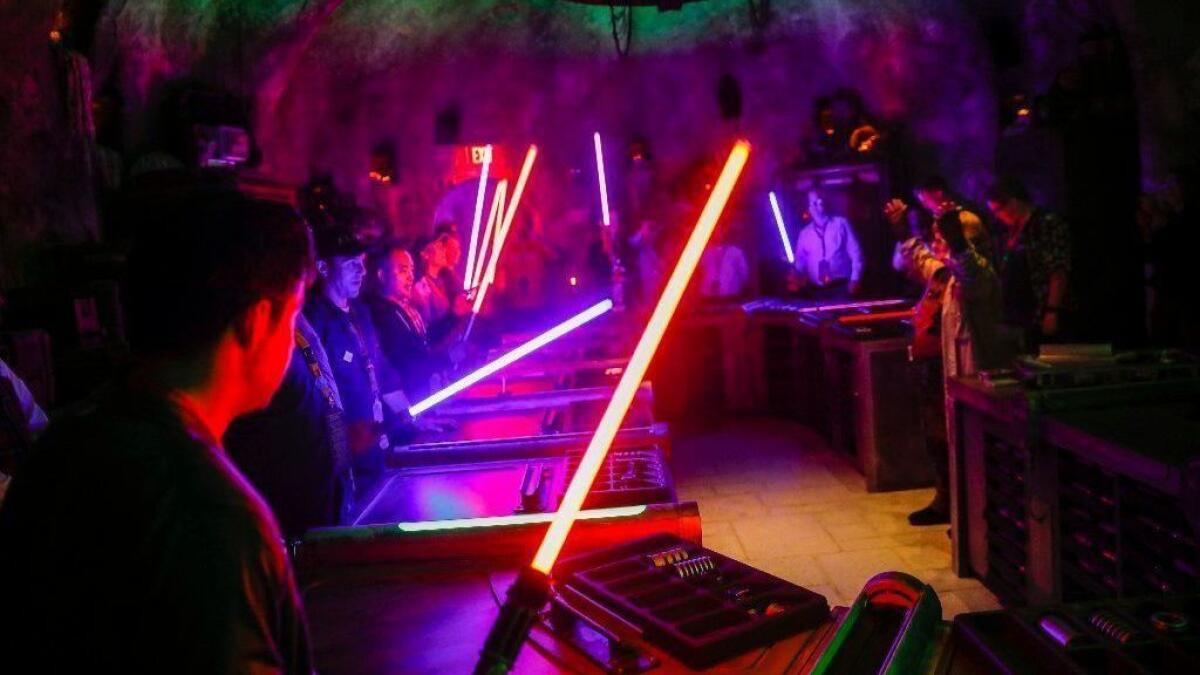
Such a backstory wasn’t necessary. We’re flying the Millennium Falcon because we’re at Disneyland and we’re at Disneyland to fly the Millennium Falcon. The story doesn’t need to be much deeper — see, for instance, Flight of Passage at Animal Kingdom’s Pandora, a ride that’s largely about the harmony of a mystical creature in nature. When you add plot to a theme park attraction, you often do so at the expense of heart, and Millennium Falcon: Smugglers Run feels crafted by people who write screenplays — those who believe “Star Wars,” particularly the history of “Star Wars,” is all-important, when in actuality it’s the fantasy franchise’s ability to inspire childlike wonder.
Here’s an instance where Imagineering could benefit from less input from Lucasfilm. A theme park, for instance, need not be canon. In fact, on Smugglers Run it’s a mistake, as it gives guests less room to imagine their own role and instead puts them on rails.
So the ride is fun, yes, but it lacks a sense of awe. And to be sure, I have felt awe, numerous times, at Galaxy’s Edge.
I felt astonishment when I built a lightsaber, a $200 endeavor that occurs in a building disguised as a secret hideaway. Without spoiling the lightsaber crafting experience too much, I’ll simply say that at one moment we hear the voice of Yoda and the John Williams score associated with the character. Even those with cursory knowledge of “Star Wars” can recognize and smile at that voice, a scraggly and humorous sound that conveys mystery, surprise, wonder, adventure and hope, all the themes we associate with “Star Wars.”
Themes, in short, that all the stolen coaxium in the world can’t replicate.
More to Read
The biggest entertainment stories
Get our big stories about Hollywood, film, television, music, arts, culture and more right in your inbox as soon as they publish.
You may occasionally receive promotional content from the Los Angeles Times.
